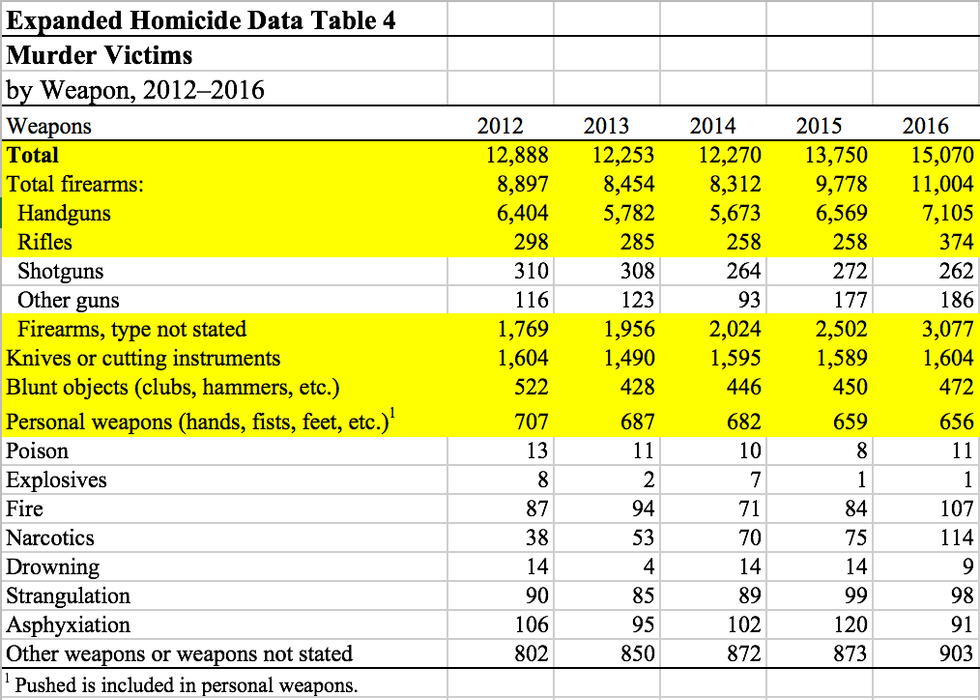As many of you are aware, last week I began an article series called "Let's Talk Gun Control," where I'm delving into the nitty-gritty details surrounding firearms in the United States. Two key pieces of information that I covered in the first article of this series were: (1) the rate of violent crime has been dramatically decreasing in the U.S. since 1991 and continues to do so, and (2) gun ownership in the U.S. has been steadily increasing.
This week, I want to take a look at data provided by the FBI and CDC regarding the role of firearms in both homicides and defensive uses of firearms by victims of crime, respectively.
The first two pieces of data that I'd like us to pay attention to are from the FBI. I have downloaded the Microsoft Excel files for both tables that I'm going to include in this article, for the purposes of highlighting particular aspects of the data that I would like to speak on at length.
This table depicts the total number of homicides committed in the United States spanning five years, 2012-2016, as well as the weapons that were used in each particular case:
I find this table particularly compelling, due to the massively disseminated talking point that the AR-15 is the deadliest weapon in the country and needs to be completely banned from civilian ownership.
However, as I've highlighted in this particular table, you are more than 23 times more likely, on average, to be killed by a handgun than you are a rifle. Even if we assume that every single gun under the "Firearms, type not stated" description is a rifle, which is obviously asinine, you are still nearly 2.5 times more likely, on average, to be killed by a handgun.
Not to mention that you are more than 9 times more likely, on average, to be killed by a knife, a blunt object, hands, fists, feet and even being pushed than you are a rifle. Again, if we assume that every single gun under the "Firearms, type not stated" description is a rifle, you are still more likely, on average, to be killed by the non-firearm methods listed.
As we can see, of the five years listed in the first table, 2016 was the deadliest of the five. So, let's take a look at this table, which breaks down the total number of homicides committed in every single U.S. state in 2016 as well as the weapons that were used in each particular case (for the purposes of keeping things short, I have filtered the data to reflect the top 5 states by number of total murders):
Clearly, every single thing that I mentioned from the first table holds true for this one. You are exceedingly more likely to be killed by a handgun, a knife, a blunt object, hands, fists, feet and a push than you are a rifle.
Now, although it's clear that rifles are in the vast minority of guns that are used in homicides nationwide, some will still argue that, even though that is clearly the case, rifles are of more importance currently due to their ostensible popularity in mass shootings.
However, a report by Mother Jones, which is certainly not a right-wing news outlet, looking at mass shootings from 1982-2012 shows that nearly 66% of the weapons used to carry out mass shootings were handguns, whereas only around 20% were rifles. Additionally, only 14% of the weapons used in mass shootings observed would be classified as "assault weapons" under the Assault Weapons Ban of 2013 proposed by Sen. Dianne Feinstein (D-CA).
Indeed, there have been more mass shootings in the U.S. since 2012, however, the data that I have provided above gets us all the way through 2016, of which I've already provided an analysis of.
The last thing that I want to look at is a study from the CDC regarding the defensive use of firearms by crime victims.
Two quotes of significant importance are:
"Almost all national survey estimates indicate that defensive gun uses by
victims are at least as common as offensive uses by criminals, with
estimates of annual uses ranging from about 500,000 to more than 3
million..."
And:
"Studies that directly assessed the effect of actual defensive uses of guns (i.e., incidents in which a gun was 'used' by the
crime victim in the sense of attacking or threatening an offender) have
found consistently lower injury rates among gun-using crime victims
compared with victims who used other self-protective strategies."
So, using the range of 500,000 to more than 3 million defensive uses of firearms per year, you are anywhere from 54 to 323 times more likely, on average, to be saved by a firearm than you are to be killed by one, based on the total amount of homicides committed by firearm per year, from 2012-2016, from the first table of data provided by the FBI.
Regardless of your political affiliation or personal beliefs in regard to gun control, I believe that this objective data will shine a light on the reality of firearms, and their use in both negative and positive ways, in the United States. It certainly has for me.





















